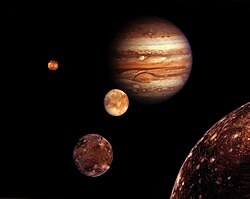Satellite
| Discovery [14] | |
|---|---|
| Discovered by | D. Gault P. Nosworthy |
| Discovery date | 19 May 2021 |
| Orbital characteristics [5] : 16 | |
| 49.9±1.0 km | |
| 32.972823 h | |
| Inclination | 30°±3° wrt ecliptic [b] |
| Satellite of | 4337 Arecibo |
| Physical characteristics | |
| 13±1.5 km [4] : 4 | |
Mean density | <1.3 g/cm3 [5] : 17 |
Arecibo hosts a relatively large minor-planet moon with a size about half its diameter, forming a binary system. This unnamed satellite orbits closely at an orbital radius of 50 km (31 mi) from the primary body of the Arecibo system, completing a full revolution in about 33 hours or 1.4 days. [5] : 16 It was discovered by Australian amateur astronomers David Gault and Peter Nosworthy while observing Arecibo occulting a star on 19 May 2021, and was confirmed in another occultation on 9 June 2021. [9] [a]
Orbit
The observed angular separation between the satellite and primary body in the 19 May and 9 June 2021 occultations were 25.5±1.0 and 32.8±0.7 milliarcseconds, respectively. [14] [4] In July 2021, Nolthenius presented a preliminary analysis suggesting that the satellite's orbital radius should lie in the range of 100–293 km (62–182 mi), based on an assumed system density of 1.9 g/cm3 and an outer orbital stability limit set by Jupiter's gravitational influence. [18] : 39 Because no photometric measurements of Arecibo's rotation period were available at that time, constraints on the satellite's orbital period were solely limited to the three occultations observed in 2021, which suggested periods of 20 days and its shorter-period aliases of 10 days, 5 days, and 2.5 days. [18] : 39
On 13 June 2022, a team of European astronomers led by Paolo Tanga, on behalf of the European Space Agency, published a proof-of-concept analysis of the Arecibo system using high-precision astrometry and photometry from the Gaia mission, as part of its third data release. [19] [5] : 16 They found that Arecibo exhibits periodic oscillations in brightness and position that are both compatible with a period of 32.972823 hours (1.3738676 d), consistent with earlier ground-based photometry from July 2021 and establishing the satellite's orbital period. [6] [5] : 16 They determined a smaller orbital radius of 49.9 ± 1.0 km (31.01 ± 0.62 mi) and an inclination of 30°±3° with respect to the ecliptic, precisely coinciding with the satellite's positions observed in the May and June 2021 occultations. [5] : 16 [b] Given the satellite's close proximity to the primary body and coincidence of brightness and position oscillation periods, the satellite is likely in synchronous orbit with the primary's rotation period. [5] : 16
Physical characteristics

The initial detection of the satellite in the 19 May 2021 occultation provided poor constraints on its size due to close spacing between the observers' sites. [14] The 9 June 2021 occultation proved to be more reliable with wider spacing between observer sites, providing a best-fit satellite diameter of 13 ± 1.5 km (8.08 ± 0.93 mi) for an assumed spherical shape for the satellite. [4] : 4 Given this diameter estimate, this makes the satellite about half the size of the primary body in the Arecibo system. [5] : 16
The satellite is massive enough to induce measurable positional wobbling of the Arecibo primary, although with an unexpectedly low amplitude of up to 2.7 milliarcseconds from Gaia's view, or 8.5% of the maximum observed angular separation between the satellite and primary. [5] : 16 This small positional wobbling of the Arecibo primary implies a very low satellite-to-primary mass ratio relative to the satellite-to-primary diameter ratio, which could either be explained by a highly flattened shape or a very low density for the satellite. [5] : 17 Tanga and collaborators favor the high flattening scenario as it yields more realistic density values and can explain the infrared underestimation of the primary's diameter. [5] : 17 In this case, the occultation-derived satellite diameter would represent its maximum shape extent and its minimum possible density would be 1 g/cm3, which is expected for a highly porous asteroid of the Themis family. [5] : 17

